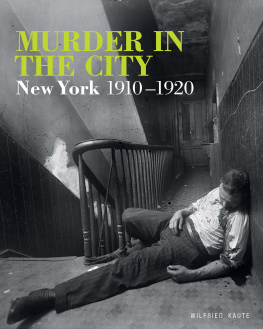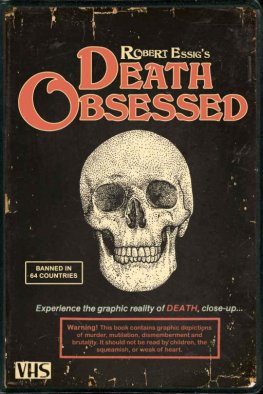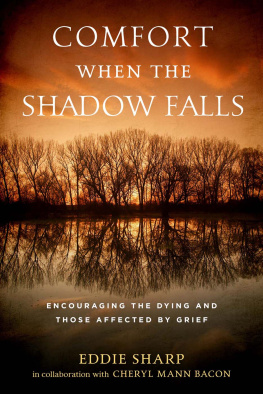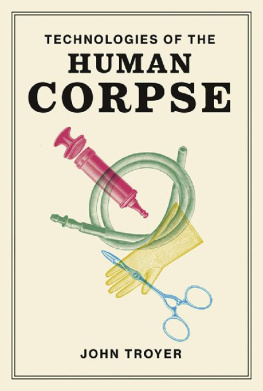Contents
Guide
MURDER IN THE CITY:
New York
19101920
WILFRIED KAUTE
THOMAS DUNNE BOOKS
ST. MARTINS PRESS  NEW YORK
NEW YORK
The author and publisher have provided this e-book to you for your personal use only. You may not make this e-book publicly available in any way. Copyright infringement is against the law. If you believe the copy of this e-book you are reading infringes on the authors copyright, please notify the publisher at: http://us.macmillanusa.com/piracy.

Subject: Police Department, Police technicians and Paraphernalia
Description: Set of burglars tools, including dark hat
Format: 7.5 x 9.5 inches

Title: Manhattan Bridge looking from roof of Municipal Building roof, also Williamsburg Bridge
Creator: Salignac, Eugene de, 18611943
Subject: Engineering, Bridges, Manhattan Bridge
Date: May 27, 1915
Print Format: Gelatin-Silver Print

Title: Homicide man at desk 1916 (?)
Subject: Crime and criminals
Date: 1916-1920
Format: 5 x 7 inches, glass-plate negative

Subject: Crime and criminals
Description: Street Scene, East 42nd and Madison Avenue
Date: 1916-1920
Format: 6.25 x 8.25 inches, glass-plate negative

Subject: Crime and criminals, Murder
Description: Homicide/Interior, undersize view of boy or man on bed, side view
Date: 1916-1920
Format: 6.25 x 8.25 inches, glass-plate negative

Title: Williamsburg Bridge view showing south roadway with white marking and 3 vehicle traffic looking east
Creator: Salignac, Eugene de, 1861-1943
Subject: Transportation, Bridges, Williamsburg Bridge
Date: December 10, 1918
Print Format: Gelatin-Silver Print
Negative Condition: Good
Negative Format: 8 x 10 inches, glass-plate negative
MURDER
MUGSHOTS
MOST
WANTED
Crime scene photography revolutionized policing in New York in the 1910s. This book collects forgotten pictures and newspaper articles from a lost era.g
BY WILFRIED KAUTE
Time and time again, the role that chance and forgetfulness play in criminal cases isnt to be underestimated. Every investigator can tell stories of witnesses who appear out of nowhere, objects that have fallen out of someones pocket or stray items of clothing that have proved to be damning evidence against the offender.
In fact, the very existence of this book is ultimately down to chance. During the renovation of the former police headquarters in New York City, hundreds of large-size glass negative plates were discovered in a small room. Among them were crime scene photographs taken between 1910 and 1920.
Today the images of this forgotten chamber form part of more than 900,000 historic items that the Department of Records the New York City archives has digitized and made accessible. The oldest of these documents date back to the mid-19th century. There are maps, cin film and audio files, but mostly photographs. They usually do not come from trained photographers, but from engineers, firemen, administrative staff or policemen, and they documented public projects, the recording of damage, accounting, and often transport and urban planning interests.
By dint of their simple objectivity, these photographs impressively depict the growth of the city. Then still gateway to the New World, New York in these photographs is on its way to becoming the first real mega-city.
The crime scene photographs included here are particularly special. According to police authority rules, the images, once finished with, ought to have been dumped, without the publics knowledge, in the Hudson Bay disposed of in the same way as confiscated weapons or gambling machines. But the scheduled destruction of the photographs was simple: they were forgotten about.
Thus they found their way into the collection of the NYPD & Criminal Prosecution, one of the largest photographic collections on criminology.
THE PHOTOGRAPHERS TASK WAS TO DOCUMENT PRECISELY AND WITHOUT EMOTION
At the end of the 19th century, photography, though still emerging itself, revolutionized solving crimes and played an important part in the fledgling field of forensic science, which was based on scientific methods and the teamwork of evidence gatherers, fingerprint experts, police photographers and coroners. The object of crime scene photography was to document what happened, precisely and without emotion. As quickly as possible, the photographer had to be at the scene of the crime, secure and unaltered, where he usually took two photographs: a long shot showing the whole room with the victim, and a close-up of the corpse. For the close-up, the camera was positioned directly above the body. Due to the strong wide-angle lens used, the feet of the photographer and the legs of the camera tripod are often visible in the image. The photographs were initially for the exclusive use of the police investigation, after which they could be used as evidence in court. Often they told a clearer narrative than the detectives statements ever could stories of cruelty and brutality.
However, crime scene photographs are not the only kind of criminological photographs in the NYPDs collection. Even so-called mugshots are included as they are still used in the identification procedure of suspects, and more recently thrust the odd celebrity involuntarily into the public eye.
Now, as then, anyone arrested is photographed front-on and in profile. Whether guilty or innocent, the suspects have to submit completely to the camera without moving. How petrified their faces can appear while being photographed. Some seem arrogant and presumptuous, others injured and confused.

Subject: Crime and criminals, Murder
Description: Homicide/male, close up of victim
Date: 1916-1920
Format: 8 x 10 inches, glass-plate negative

Title: Copy Henry Monroe photo & measurements
Subject: Crime and criminals
Description: Copy photo
Date: 1916-1920
Format: 8 x 10 inches, glass-plate negative
Condition: paper stuck to emulsion
That none of the images at the time was intended for the public is part of their appeal.











 NEW YORK
NEW YORK






